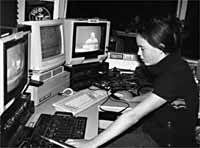Technology educators encourage nonlinear learning
By TRAVIS PURSER
Express Staff Writer
 Ask Blaine County School District administrators and
teachers what uses students are putting computers to these days and you’re likely to
get a wide range of answers. Some will give you broad categories, such as research, skill
development and active learning. Others will name specific software, such as Microsoft
Word or Hyper Studio. Still others will name on-line services such as Epsco, InfoTrac or
Electronic Library.
Ask Blaine County School District administrators and
teachers what uses students are putting computers to these days and you’re likely to
get a wide range of answers. Some will give you broad categories, such as research, skill
development and active learning. Others will name specific software, such as Microsoft
Word or Hyper Studio. Still others will name on-line services such as Epsco, InfoTrac or
Electronic Library.
The list goes on and on, but the common denominator, everyone seems to
agree, is that Blaine County schools have ineluctably entered the Information Age.
From the Stone Age to the Industrial Revolution, people adapted to
technological change. But what is different now, says Wood River Middle School teacher
Brad Thode, is that computers and the Internet are significantly changing the way students
learn.
Brad Thode and his wife, Terry, are nationally recognized pioneers in
nonlinear learning. The term "nonlinear," Brad Thode says, refers to students
doing different projects at different times. It is also the way the Internet, with its
never-ending series of hyperlinks, is organized.
"We don’t all sit at a desk and do the same thing," says
Terry Thode of her Hemingway Elementary students. "When a first-grader wants to know
about lasers, and says his older brother is learning about them, we don’t say,
‘Well, you’ll learn about that at the middle school.’ We stop what
we’re doing, and learn about lasers right now."
Brad Thode calls that initial interest in a subject the teachable
moment, during which critical inquiry, and not teachers, drives learning.
The Thodes hope that through this new approach to learning,
traditionally separate subjects such as math, science and language arts will become
integrated, and thereby become more meaningful to students.
"We’re pretty excited about teaming up with math and science
teachers under the theme of engineering," he says.
As for integrating the arts and humanities, Brad Thode points to a
student-built radio station and television studio in his technology lab, for which
students must write scripts for their daily broadcasts around the school.
Thode has had some impressive results from allowing students to direct
the course of their learning. A visit to his 6,000-square-foot, multiroom technology lab
can overwhelm the senses.
Taking up most of the floor space, counters and walls, and suspended
from the ceiling, are all kinds of projects that his students have researched, designed
and built using computers. These projects include a wind tunnel, a flight simulator, a
six-legged walking chair, and a space station, to name just a few.
The ideas for these projects come entirely from the students, Thode
insists, pointing out a list of topics students maintain on the blackboard throughout the
year, adding that students address the topics in any sequence they wish.
In the near future, the Thode’s nonlinear teaching approach may
find its way into other, more traditional classrooms.
According to district technology coordinator Teresa McGoffin, every
classroom in the district now has at least one computer with Internet access through a
high-speed T1 connection to the school’s local area network (LAN), and every school
is connected to the district’s wide area network (WAN).
The district’s recent proliferation in computer technology is the
result of a more than $10 million-per-year statewide program to provide teachers and
students with more access to computers. Money has also has come from federal and private
grants.
As a result, there are now more than 600 Internet-connected computers
in the district, according to McGoffin. The next step will be for educators to decide how
to get the most out of those computers in educating students, she says.

